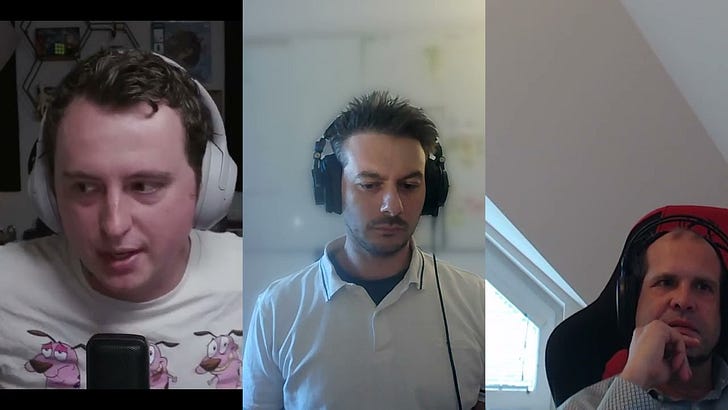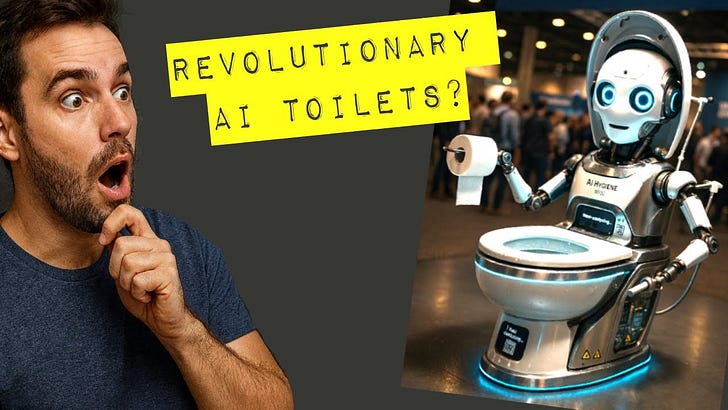Listen (and watch) all our episodes here! Youtube
Let me tell you a story about a man who rode two AI waves, made $60 million, and nearly destroyed himself in the process.
His name is Xaver Lehmann. You probably haven’t heard of him. That’s precisely why you should listen.
While the venture capital circus performs its tired trapeze act—Samsung and SK just joined OpenAI’s $500 billion Stargate initiative, because apparently we’re summoning either aliens or just more server racks—Lehmann is writing a different playbook. One that involves saying “fuck you” to investors, embracing the chaos of Substack, and building companies that don’t require you to sacrifice your nervous system on the altar of quarterly metrics.
This is the story the Forbes 30 Under 30 lists won’t tell you.
The Accidental Prophet of Human-in-the-Loop AI
Picture Munich, 2016. Two students with zero coding skills, zero industry experience, and zero business acumen decide to build an AI company.
The audacity is almost beautiful.
Lehmann and his co-founder Fabian caught the first AI wave before ChatGPT made everyone a prompt engineer. They built eBot7—a conversational AI platform that didn’t just automate customer service, it created a hybrid system where AI suggested responses and humans approved them. Not because they were visionaries. Because the technology simply wasn’t ready yet.
“The problem was you needed to train them in advance for weeks, even months or even years until you can actually deploy them,” Lehmann explains. “And we had a system which you could actually deploy instantly.”
Human-in-the-loop before human-in-the-loop was cool.
They sold to Deutsche Bahn, BMW, HDI insurance. Within five years, they had 130 people and a $60 million exit to a US Nasdaq company.
Sounds like a fairy tale, right?
Wrong.
When Success Eats You Alive
Here’s what the success porn merchants on LinkedIn won’t tell you: that nine-month M&A process nearly killed him. Literally.
“I was at the notary, I was completely fucked up. My body was just not moving anymore. My brain was completely frozen. I couldn’t breathe anymore almost.”
This wasn’t exhaustion. This was burnout—the kind where you can’t read books, can’t drive cars, can’t be human. Where you exist but you’re not inside your body anymore.
The trigger? Not hard work. Fear.
Every single day for nine months, the deal could collapse. They’d already turned down investors, betting everything on the sale. Meanwhile, his mother was dying. American lawyers working across time zones. Endless negotiations over minutiae. The constant terror that it would all evaporate.
“Like having four, five, six hours or even 10 hours of lawyer calls every day for months is not something someone who can ever enjoy.”
And here’s the kicker: this is what we celebrate. This is what motivates keynote speeches and founder mythology.
We’re worshipping at the wrong altar.
The Infrastructure Gold Rush Nobody’s Talking About
While Lehmann was rebuilding his nervous system in South Africa (more on that later), the AI industrial complex hit a new fever pitch. Citi now projects hyperscalers will burn through $490 billion on infrastructure. That’s not a typo. Half a trillion dollars on data centers, chips, and compute.
Samsung and SK joining OpenAI’s Stargate isn’t just news—it’s a signal flare that the consolidation wars have begun. The AI bubble discourse is missing the point entirely. As Reuters noted: “If AI is a bubble, the economy will pop with it.”
But here’s what Lehmann sees that most don’t: “I’m not sure if I would found a company right now because it could be that in a week’s time it’s over again.”
The speed of obsolescence has become absurd. He spent three months building software to make AI write in your authentic voice—psychological analysis, tone mapping, the works. A week after completion, new tools solved it.
OpenAI just dropped Sora 2. Lovable and Bolt are turning business people into developers overnight. The competitive moat isn’t in the technology anymore.
It’s in something else entirely.
The Death of Software As We Know It
Lehmann predicts something most founders haven’t internalized yet: we’re heading toward the end of traditional software interfaces.
“Do you actually need websites anymore?
Do you need software anymore if you have that kind of tool?” he asks, describing a future where AI agents just execute your intent.
“Because you could just tell him, ‘Can you send 10 emails to these and that.’”
Think about it.
Your Linux friends already know this: command line is faster than UI when you’re fluent in the language. AI is making everyone fluent.
We’re returning to text on screen. Full circle back to the 1980s vision where you just tell the computer what to do. The $490 billion infrastructure build-out isn’t about better chat interfaces—it’s about creating the substrate for fluid software that morphs to your task in real-time.
Google AI Studio is already pointing this direction. The question isn’t whether this future arrives.
The question is: who builds companies that survive this transition?
The Substack Rebellion
Here’s where Lehmann made his most contrarian move: he walked away.
After the second AI company (VidLab7, with avatars), his body said “stop” again.
So he went to Africa for four months, came back, and started writing on Substack instead of raising another round.
“I don’t want any employees.
I don’t want any investors.
I’m just my own boss.
I can do whatever I want.
I can go on holiday whenever I want.”
The Honest Founder—his Substack—is something different.
It’s not the zombie engagement factory of LinkedIn, where you comment before posting to appease the algorithm gods and harvest hollow “I agree!” responses.
“On LinkedIn it feels like zombies. Almost everything, 95% is fake comments because you know you can’t be too controversial.”
Substack restores the old internet’s promise: actual human conversation. His wife, a psychologist working with burned-out entrepreneurs, saw the same pattern. On LinkedIn, diligent daily posting about burnout generated minimal genuine engagement. On Substack, real conversations emerged.
One note went semi-viral—2,000 subscribers in a day for someone in his network. Not because of algorithm manipulation. Because of resonance.
This isn’t nostalgia.
This is pattern recognition.
The Bootstrap Manifesto
Thirteen investors in his first company. Eight or nine in the second. Lehmann is done with that game.
“If I founded a new company now, I would definitely bootstrap.”
Not because investors are evil. Because dependency is a cage. You’re optimizing for the next round instead of customers. You’re worried about what the board thinks instead of what users need. Every decision is filtered through “will they invest again?”
The math is damning: 70% of investors produce negative returns. Most founders develop more insights in three years of grinding than investors parachuting in with pattern-matching advice.
“You risk being worried about what the investor thinks instead of what the client thinks.”
His alternative? Seedstrapping—raise one small round from angels or family, then become profitable and bootstrap from there. Or skip it entirely if you have runway.
The democratization of development tools makes this viable now. Lovable created his longevity health platform MVP in four hours. Four hours. In 2016, that would have looked like three years of work.
The only real moat left?
“Hiring the right people, I would say. That’s the number one.”
The Gratitude Hack Your Brain Needs
Before you think this is just another “VC bad, bootstrap good” sermon, understand what kept Lehmann functional: daily practices that sound soft but are structural.
Seven minutes of genuine gratitude journaling. Not performative Instagram affirmations. Deep gratitude for specific things. He started with “I learned English, my life changed” and ended with “I’m grateful I can breathe.”
“Gratitude is definitely the one cure that if you feel anger, if you feel sadness, if you feel something negative, gratitude will solve it.”
No phone in the bedroom.
Meditation before email.
Gym breaks.
Tracking when his body says “stop.”
This isn’t self-help fluff. This is infrastructure for your nervous system. Because your brain isn’t built for happiness—it’s built for survival. It scans for threats constantly.
You have to actively manage that default state or it will manage you.
Ask Bollywood stars now suing over AI voice cloning if they’d rather have controlled their identities proactively.
The Real North Star
Bezos has customer obsession. Lehmann has people.
“If you have the right people, it’s fun to work. It’s something completely different that you challenge yourself. It’s not only colleagues, it’s more friends.”
Bad people drag down good people until everyone is bad. A great team with a shitty product can pivot to success. A shitty team with a great product will crater.
Formula 1 teams know this. Ferrari’s engineer told him their car is “all about people and the rest almost takes care of itself.”
Bezos allegedly chose Seattle because Microsoft was there—great talent pool, less competition than San Francisco. Strategic talent arbitrage.
Lehmann chose something harder: building a life where his body doesn’t rebel. Where he can drop work at 4 PM without asking permission. Where he helps other founders avoid his mistakes through weekly Substack posts instead of VC pitch meetings.
What This Actually Means
The EU is lagging China in AI adoption because of regulatory friction. Hyperscalers are spending half a trillion on infrastructure. Charts about AI are committing fraud with exaggerated claims.
None of this matters if you’re building wrong.
Timing matters—ride waves, don’t fight gravity. But timing without sustainability is just a slower path to burnout. The M&A processes will still grind you. The investor pressure will still distort your decisions. The fear will still accumulate in your body until you can’t drive cars anymore.
Lehmann rode two AI waves. Made Forbes 30 Under 30. Sold for $60 million.
And nearly destroyed himself doing it.
Now he’s in Sardinia, helping rhinoceros conservation with drone surveillance and writing frameworks to help founders avoid his path. His new North Star isn’t growth metrics.
It’s freedom.
The AI infrastructure arms race will continue. The bubble discourse will rage. Someone will launch Sora 3 and claim it’s revolutionary.
But ask yourself: are you building something that serves you, or something that consumes you?
Because in the end, no exit check is worth not being able to breathe.
About the podcast: This conversation is part of exploring how technology reshapes human experience—the successes nobody photographs and the costs nobody mentions. For more unfiltered founder stories and frameworks that actually work, follow Xaver Lehmann’s Substack “The Honest Founder” or visit xaverlehmann.com.
The uncomfortable question: If your company succeeds beyond your wildest dreams but leaves you unable to drive, read, or exist normally for six months afterward—did it really succeed?















